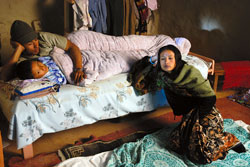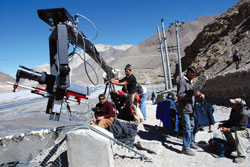|
|
With the openness in Nepali media, and a boom in documentary filmmaking in late 1990s, film critics, audiences and film enthusiasts hoped that some of the investment, enthusiasm and expertise would influence feature filmmaking.
In 2000 Quest Entertainment started movie exhibition business via the duplex Kumari Cinema and Jai Nepal in Kathmandu. Right from the time the theatres opened the owners saw that there was a clear demand for Hindi and Hollywood movies. They observed the crowds and concluded rightly that they would never watch mainstream Nepali movies.
The demand for multiplexes was growing in India and more Bollywood directors were looking to have their films released internationally. Hindi movie directors had understood that the money was in middle and upper middle-class audiences, and Indians living abroad determine the success and failure of movies. However, in Nepal it was exactly the opposite.
"It is the general masses who determine the success and failure of mainstream Nepali movies, and the middle and upper-middle class do not even consider watching commercial Nepali films," explains Bhaskar Dhungana of Quest Entertainment. One reason is because the Kathmandu movie industry is not open to change and does not understand that filmmakers need to evolve.
Dhungana was keen on making a Nepali movie that is different, so he got together with others who shared his vision, and discussed the possibility of working on a feature film that would impress even those who are used to Bollywood and Hollywood. Quest sought help from those who worked in the music video industry because it understood digital media and had successfully used it.
The filmmakers brought in the high-definition digital camera that Silken Imaging, an American company, was just trying out. In October 2006, the cast and crew set off to Jomsom. They shot non-stop for thirty days in Kagbeni, Marpha and Shyang.
"The camera is as big as a CCTV and does not use tapes for recording, everything is saved on hard disk," explains director Bhusan Dahal. The challenging part was that the crew was a guinea pig for the camera in South Asia, so every time there was a technical problem they had to walk a few hours to a cyber caf? to write to the US manufacturers and wait for instructions by email.
Kagbeni is the Nepali adaptation of W W Jacobs' Monkey's Paw. The story begins with Krishna coming back to his village after spending time in Malaysia. After visiting his friend Ramesh, they decide to travel together. On their journey they come across a hermit who hands Krishna an animal's paw that has power to fulfil wishes, but also create horrific consequences. Unaware of its ominous powers, Ramesh makes a wish, and the journey of betrayal and revenge begins.
The filmmakers say that the story will remind the audiences of Nepali folk stories. They describe Kagbeni as a dark drama and say that the story is very simple. "If you compare it to other mainstream films, it is less noisy, there's uniformity in terms of colour and tint, and the film does not exaggerate," says Dahal.
Kagbeni is releasing in theatres on 11 January. Quest Entertainment has digitised
14 theatres all over Nepal, with most theatres also upgrading to digital surround sound. "It took a lot of coaxing, cajoling and convincing the theatre owners about the benefits of digitising movie theatres, not just for this, but also future releases," says Dhungana, who is also the producer of the film.
Kagbeni is directed by Bhusan Dahal, produced by Bhaskar Dhungana, Nakim Uddin and Rajesh Siddhi. The film features dancer-turned-actress Deeya Maskey, pop singer Nima Rumba, actors Saugat Malla, Puja Gurung, Hanif MD, and Anup Baral. Kagbeni is the first Nepali film releasing simultaneously all over Nepal, Darjeeling, Kalimpong, Siliguri, Sikkim, Dehradun, Shimla, Delhi, Calcutta, Mumbai and New York.
Into the silver screen
 |
Maskey plays the leading female role in Kagbeni. "I was immediately absorbed into the story, and as soon as I realised that my role was more than just being a pretty face, I wanted to be that character," says Maskey.
Maskey says she wants to put her 100 percent in whatever projects she takes up. "Professionalism is very important to me," Maskey adds. After shooting Kagbeni, she is splitting her time between working on music videos and is preparing for stage performances in Dubai and the US. She is looking forward to doing more theatre and lots of good acting in the coming year.
For the longest time, pop singer Nima Rumba could not quite figure out why in a country where music, radio, and music videos were doing so well, feature films were not making it. "I knew it wasn't talent that we were lacking because I meet so many talented people everyday through my work," says Rumba. When he heard the story of Kagbeni, he immediately knew that was what he wanted to do. "I knew Kabeni was going to be different, it would be a milestone, and I just knew I had to be a part of the change," Rumba adds.
Rumba was offered the lead role, but it was the character of Krishna that attracted him: "Krishna has travelled, is single, street smart and has so many stories to tell, I knew I had to play him."
Many have asked Nima Rumba if he is going to give up singing now that he is an actor but he says he will do both. His next album will be released this year.



